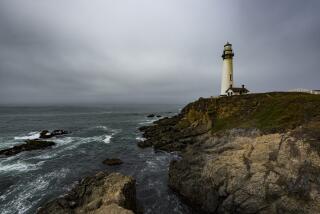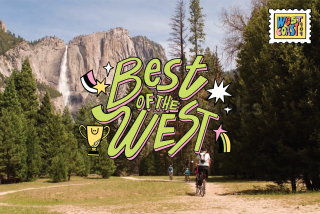On the Oregon Trail
- Share via
BAKER CITY, Ore. — There are ways of expressing patriotism besides waving the flag. Two weeks after the horrors of Sept. 11, I found mine by driving the last 430 miles of the old Oregon Trail, which took about 300,000 emigrants west between 1841 and 1869.
I didn’t know exactly what I was looking for on my five-day trip from Boise, Idaho, to Portland, Ore. Fall colors, lightly traveled roads, antiques, the warmth of country inns and food, the friendliness of strangers. Slow-lane, old-fashioned, Reader’s Digest Ameri-ca. There would be comfort in that, I hoped.
I wanted to take my time for detours and frequent stops at historic markers along Interstate 84, which roughly follows the trail through Idaho and Oregon so I could rest where the pioneers camped, see the vistas they saw, think their thoughts. I wanted to commemorate the trail’s heroes, hiss its villains and take time to consider the national sense of entitlement that drove the pioneers west and that came to be called Manifest Destiny.
Most of all, I wanted to be moved by a wide-open swath of American scenery.
The Oregon Trail runs 2,000 miles across public and private land from Independence, Mo., to Oregon City, just south of Portland, and is marked by plaques with stirring passages from pioneer journals. Though there were other important routes west, this was the mother road, scouted by fur trappers, mountain men and missionaries.
Wagon trains left Independence in the spring on a trip that lasted five to six months. When they reached what is now the border between Idaho and Oregon, they had traveled more than 1,500 miles. Unfortunately, the hardest part of the trip lay before them, across the harsh high desert of eastern Oregon, over the Blue Mountains, then north to the Columbia River, which took them on a wild ride to the Pacific Coast.
“To be sure our going was not like riding a Pullman Palace Car ... yet we were content to go on our way with the best that God gave us wisdom to employ.” Sarah J. Cummins, 1845 emigrant
*
I flew to Boise, rented a car and headed northwest on I-84, vainly trying to imagine myself on the seat of a buckboard wagon with a flapping canvas top, behind a team of oxen that covered three miles an hour at best. The day was hot and airless, the sky baby blanket blue, the horizon endless.
I got off the highway 20 miles west of Boise, at the exit for U.S. Highway 20/26 and Parma, Idaho. Soon I found myself in countryside that looks something like Kansas. There were grain elevators and trucks full of onions, trailing skins. On the east edge of Parma, there’s a stolid, unatmospheric re-creation of Ft. Boise, a fur trapper way station that provided a small measure of comfort to Oregon Trail travelers. It was actually about 10 miles north, at the place where the pioneers crossed to the west bank of the Snake River, just over the Oregon state line in Nyssa.
From the Nyssa ford, I followed U.S. 20/26 to Vale on the Malheur River, which irrigates 300,000 acres of Malheur County. Vale is a tired high-desert town with an Oregon Trail kiosk that explains how pioneers cleaned up in nearby hot springs before pushing on.
Of course, the emigrants had no kiosks to tell them where they were. To get to the Willamette Valley, they relied on such landmarks as nearby 266-foot Malheur Butte, the records of earlier emigrants, guidebook writers and wagon train leaders.
Alas, some of the wagon masters were less skilled than others. In 1845, Stephen Meek persuaded a party of about 100 wagons to follow him on a cutoff from Malheur to an apocryphal south pass through the Cascade Mountains. Instead of finding a shortcut to the Willamette Valley, the group went astray on the barren northern fringes of the Great Basin. Two dozen people died before the Meek party finally blundered north to the Columbia River.
Modern travelers have it far better, though the trail markings are still a mishmash: tall new wood kiosks; faded old road signs for obscure auto-tour itineraries; and stone plinths, placed along the way at different times.
From Vale, I turned east to Ontario, where I rejoined I-84 and drove the glorious 60-mile stretch of highway to Baker City. There the interstate follows the canyon of the Burnt River, by all accounts one of the meanest, roughest, steepest passages on the whole trail.
I stopped briefly at lovely Farewell Bend State Park, where emigrants left the Snake River, thereby avoiding its treacherous course through Hells Canyon to the north. Looking back, that part of the drive was the finest and most therapeutic. I’d never been in a high desert like eastern Oregon before, all rolling Thomas Hart Benton hills, camel-hair-colored and sagebrush-scented.
The backbreaking trip up Burnt River Canyon wouldn’t have been therapeutic to the pioneers, but after that, a first look at the wide, grassy Lone Pine Valley would have been. Named for a tree that was subsequently chopped down, the valley cuddles up to the Elkhorn Mountains to the west, gets water from the meandering Powder River and, when gold was found to the southwest, became the home of Baker City, now a thriving county seat with a population of about 10,000.
The eastern Oregon town is a place where the rain smells divine, swings in the city park go high and the whistles of freight trains mark the passage of time. Baker City has a handful of historic homes like the Victorian Adler House, a compact downtown that looks like a western movie set and a landmark 1889 hotel, the Geiser Grand, where the cast of “Paint Your Wagon” stayed during the filming of the 1969 Alan Jay Lerner and Frederick Loewe movie musical. I settled in to a third-floor room with two queen beds, high ceilings and windows overlooking the Elkhorns.
*
“Traveled 14 miles, crossed the river about a dozen times. Found some pretty hard hills and rough road ... very tired come night and very weak. Saw seven graves and 12 dead cattle.”
Martha S. Read, 1852 emigrant
*
I woke up thinking about the incredible journey of the pioneers. Why did they do it, I wondered, then found the answer at the National Historic Oregon Trail Interpretive Center, perched at the top of a windy hill about 10 miles east of Baker City. It is one of five such centers that have sprung up along the trail in Oregon in the last decade.
Visitors are greeted by a life-size diorama of trail scenes, complete with rusty horseshoes, watchful Indians, emigrant graves, sagebrush and cow pies. At the end of the display, a huge picture window provides sweeping views of the valley and a network of footpaths below. These lead about a mile down Flagstaff Hill to a stretch of the trail; there, a replica of a covered wagon stands atop authentic ruts.
The adjacent exhibition galleries correct some common misconceptions about the trail. In many places it wasn’t just a single file of wagons; the pioneers often spread out to avoid the dust that others kicked up. They circled their wagons more to protect livestock than to guard against Indian attack, and about 30,000 pioneers died along the way, most succumbing to accidents and disease, not attacks.
Other exhibits tell how economic depression in the late 1830s, pioneer missionaries and the fear that the British would beat America to the Pacific Northwest encouraged mass migration, which peaked in 1852, when 70,000 people followed the Oregon Trail west.
*
“Out in Oregon the pigs are running about under the great acorn trees, round and fat, and already cooked, with knives and forks sticking in them so you can cut off a slice whenever you are hungry.”
Peter Burnett, 1843 emigrant
*
I abandoned the trail the next day for a detour to Hells Canyon, a two-hour drive east of Baker City on Oregon Highway 86. This deep gash carved by the Snake River plays a small but significant role in the westward expansion story. In 1811, a party of voyagers dispatched by business tycoon John Jacob Astor to establish trading posts in the Pacific Northwest tried to follow the canyon north to the Snake’s confluence with the Columbia River. At the time, winter was closing in, food was scarce and the group could neither float on the treacherously rapid river nor pass along its precipitous banks. The trip was so harrowing that the company--and subsequent Oregon Trail emigrants--abandoned the canyon route altogether.
These days, though, canyon overlooks at such spots as Copperfield, site of Oxbow Dam, are easily accessible by way of Oregon 86. On the way there, the road alternately scales high desert passes, yielding breathtaking views of the Wallowa Mountains, and cuts through ridges of rock with the canyons of the Powder River and Pine Creek. There I stopped to do a little panning and struck riches in the form of stream-side bushes and trees just kissed with autumn gold.
I spent the night in the mountain-cupped hamlet of Halfway, at Clear Creek Farm B&B;, a shady Victorian farmhouse amid a 160-acre cornucopia of orchards and fields. In the Rose Room, which had an elegant queen bed and window seat, I fell asleep while cows bawled. Early the next morning I walked to the orchards, where pear trees sagged under the weight of ripe fruit, and decided that the pioneers had been well advised to seek paradise on Earth in Oregon.
*
“Looks as if we were coming somewhere.”
Diary of Cecilia McMillen Adams and Parthenia McMillen Blank, twins on the Oregon Trail, 1852
*
My fourth day took me back toward Baker City, following beautiful country lanes such as Keating Road and Miles Bridge Road north to Oregon Highway 203 on my way to La Grande.
The town sits beneath the Blue Mountains in the Grande Ronde Valley, a place right out of “America, the Beautiful.” Some Oregon Trail travelers thought about staying there, and when later emigrants found the best land in the Willamette Valley was taken, they returned to the Grande Ronde, establishing the town in the early 1860s.
La Grande has a memorial to the pioneers in Birnie Park, cemeteries with emigrant graves, a tidy business district and Stang Manor B&B;, a gracious Colonial Georgian mansion near downtown. I stopped just long enough to check in and drop my bags in a pretty room on the second floor above the rose garden. Then I set off to the Whitman Mission National Historic Site, about 10 miles west of Walla Walla, Wash.
To make this long but important detour, two hours each way from La Grande, I took I-84 northwest over the Blue Mountains to Pendleton, where I turned northeast on Oregon Highway 11 to Walla Walla. Along the way there were several Oregon Trail campsites to explore, like Emigrant Springs State Park and Deadman Pass, where tired pioneers caught sight of the vast Columbia Plateau and the Cascade Mountains, their last two hurdles. (Unfortunately, the Oregon Trail Interpretive Park at Blue Mountain Crossing, site of some of the best-preserved wagon ruts, was already closed for the season.)
Today little remains at Whitman Mission, founded by the missionary couple Marcus and Narcissa Whitman, besides a hilltop monument, building sites, a small museum and wagon ruts. (The trail passed through the compound until 1844.) The Whitmans married months before going west in 1836. Narcissa was handsome and articulate, one of the first white women to travel the Oregon Trail. Marcus, a physician, helped to blaze the way but ran afoul of the Cayuse Indians when he couldn’t save the tribe from a measles epidemic brought west by the emigrants. Partly as a result, the Whitmans and 11 others were killed by a band of Cayuse at this quiet spot near the Walla Walla River in 1847.
*
“Travel, travel, travel--nothing else will take you to the end of your journey; nothing is wise that does not help you along.”
Marcus Whitman, 1843
*
The next day, with a flight to catch in the evening and about 300 miles of the trail to go, I decided to limit my ramblings and just drive across the Columbia Plateau to the river and its incomparable gorge. But I had to stop at the Pendleton Woolen Mill, which started making Indian blankets in 1909 and had a red tartan car rug I probably should have bought.
The nearby Tamastslikt Cultural Institute, a handsome, low-slung complex built by the Confederated Tribes of the Umatilla Reservation in 1998, was another place I couldn’t pass up. Its high-tech multimedia displays describe the history and culture of the region’s Umatilla, Walla Walla and Cayuse Indians, their extraordinary horsemanship, recent attempts to bring spawning salmon back to the Umatilla River and, of course, the Indians’ reaction to Manifest Destiny.
It’s a familiar story of the Native Americans’ initial curiosity and gestures of friendship toward the pioneers, of imported disease and disenfranchisement, and sometimes of violent resistance, as in the Whitman massacre. Together with the Oregon Trail Interpretive Center in Baker City and the Whitman Mission, Tamastslikt teaches a lesson about how it’s often necessary to hold diametrically opposing views to get at historical truth.
Back on the road, I reached the Columbia River at Boardman, then saw the John Day Dam and perfectly proportioned, cloud-swaddled Mt. Hood, the 11,239-foot beacon of the Cascades. When I reached The Dalles, where Oregon Trail pioneers had to decide whether to risk the river rapids by boat or cross the Cascades on the tough Barlow Trail, one last stop was required at the Columbia Gorge Discovery Center. It has a show-stopping picture and displays on the geology of the gorge and the advent of steamboats on the Columbia.
As I flew back to L.A. that night, full of a quiet love of country that surpasses patriotic fervor, a quote from novelist Thomas Wolfe that I’d read at the Baker City Oregon Trail Interpretive Center stuck in my mind: “It is a fabulous country ... the one place where miracles not only happen, but where they happen all the time.”
(BEGIN TEXT OF INFOBOX / INFOGRAPHIC)
Guidebook: On the Oregon Trail
* Getting there: You can begin your Oregon Trail trip in Boise, Idaho, or Portland, Ore. From LAX, Alaska flies nonstop to Boise, and Southwest flies direct. Restricted round-trip fares begin at $144. From LAX to Portland, Alaska and United offer nonstop service; restricted round-trip fares begin at $138. Most of the major car rental agencies are represented at those airports.
* Where to stay: Geiser Grand Hotel, 1996 Main St., Baker City, OR 97814; (888) 434-7374 or (541) 523-1889, fax (541) 523-1800, https://www.geisergrand.com, is a vintage Victorian lodging downtown, with large, well-appointed rooms, a restaurant and bar; doubles $89 to $199.
Clear Creek Farm B&B;, 48212 Clear Creek Road, Halfway, OR 97834; (800) 742-4992 or (541) 742-2238, fax (541) 742-5175, https://www.neoregon.com, has five B&B; rooms for $99 to $114 and cabins for $65, double occupancy, including breakfast. The inn is closed for the winter until April 1.
Stang Manor Inn, 1612 Walnut St., La Grande, OR 97850; (888) 286-9463, telephone/fax (541) 963-2400, https://www.stangmanor.com, has four rooms for $85 to $98, double occupancy, including breakfast.
* Where to eat: In Baker City, try the restaurant at the Geiser Grand Hotel (see above), with such specials as a mesquite-smoked prime rib dinner for $14.95 (reduced to $9.95 on Mondays).
Also recommended: the Phone Co. Restaurant, 1926 1st St., (541) 523-7997, which has steak, fish and pasta entrees for $9.95 to $19.95.
In La Grande, Foley Station, 1011 Adams Ave., (541) 963-7473, is a warm restaurant with a sophisticated menu that includes such dinner entrees as tournedos Henry IV for $21 and halibut with huckleberry butter for $18.
* For more information: Oregon Tourism Commission, 775 Summer St. N.E., Salem, OR 97301; (800) 547-7842, https://www.traveloregon.com.
More to Read
Sign up for The Wild
We’ll help you find the best places to hike, bike and run, as well as the perfect silent spots for meditation and yoga.
You may occasionally receive promotional content from the Los Angeles Times.






